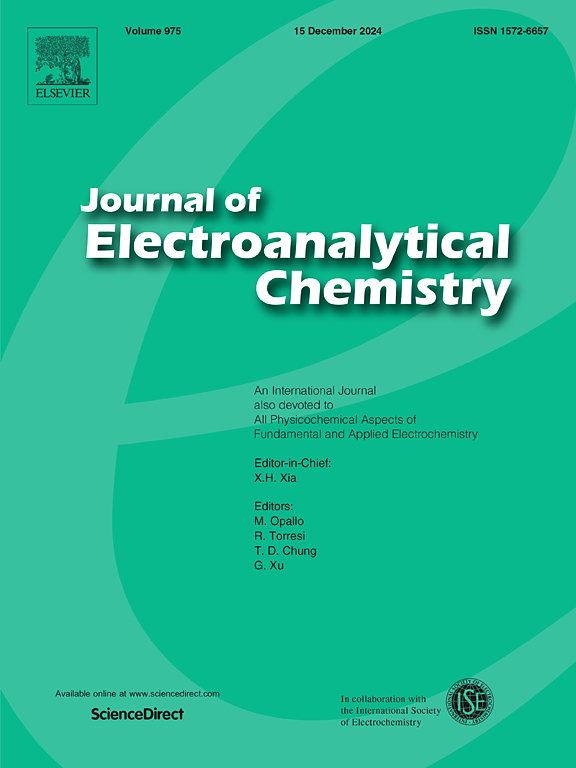Antimony doping improves the performance of cobalt‑vanadium hydrotalcite as the electrode of supercapacitors
IF 4.1
3区 化学
Q1 CHEMISTRY, ANALYTICAL
引用次数: 0
Abstract
Due to its limited charge transfer capability, the layered double hydroxides (LDHs) material struggles to fully realize its ultra-high theoretical energy storage capacity when utilized as a supercapacitor electrode. The introduction of heteroatoms is widely regarded as an effective strategy for modulating charge distribution in LDHs materials. Herein, to address the issue of weak conductivity, the local charge distribution of CoV LDHs nanomaterials was modified through elemental doping with the metal element antimony, thereby enhancing their intrinsic charge conduction capabilities. As a result, the Sb-CoV LDHs-0.2 exhibits a specific capacitance of 326.7 F g−1 at a current density of 1 A g−1, which is 1.6 times higher than that of CoV-LDHs. Furthermore, the asymmetric supercapacitor, assembled with Sb-CoV LDHs-0.2 as the positive electrode and commercial activated carbon (AC) as the negative electrode, achieves an energy density of 10.1 Wh kg−1 at a power density of 943.6 W kg−1. Additionally, under a current density of 5 A g−1, the device demonstrates remarkable cycling stability, with no observable capacity attenuation after 10,000 consecutive charge-discharge cycles. These results suggest that antimony elements significantly enhance the charge transfer and durability of LDHs materials.

锑的掺杂提高了钴钒水滑石作为超级电容器电极的性能
由于其有限的电荷转移能力,层状双氢氧化物(LDHs)材料在用作超级电容器电极时难以充分实现其超高的理论储能能力。杂原子的引入被广泛认为是调制LDHs材料中电荷分布的有效策略。本文针对CoV LDHs纳米材料导电性弱的问题,通过元素掺杂金属元素锑来修饰CoV LDHs纳米材料的局部电荷分布,从而增强其固有电荷传导能力。结果表明,Sb-CoV LDHs-0.2在电流密度为1 a g−1时的比电容为326.7 F g−1,是CoV-LDHs的1.6倍。此外,以Sb-CoV LDHs-0.2为正极,商用活性炭(AC)为负极组装的非对称超级电容器在943.6 W kg - 1的功率密度下实现了10.1 Wh kg - 1的能量密度。此外,在5 a g−1的电流密度下,该器件表现出显著的循环稳定性,在连续10,000次充放电循环后没有观察到容量衰减。这些结果表明,锑元素显著提高了LDHs材料的电荷转移和耐久性。
本文章由计算机程序翻译,如有差异,请以英文原文为准。
求助全文
约1分钟内获得全文
求助全文
来源期刊
CiteScore
7.80
自引率
6.70%
发文量
912
审稿时长
2.4 months
期刊介绍:
The Journal of Electroanalytical Chemistry is the foremost international journal devoted to the interdisciplinary subject of electrochemistry in all its aspects, theoretical as well as applied.
Electrochemistry is a wide ranging area that is in a state of continuous evolution. Rather than compiling a long list of topics covered by the Journal, the editors would like to draw particular attention to the key issues of novelty, topicality and quality. Papers should present new and interesting electrochemical science in a way that is accessible to the reader. The presentation and discussion should be at a level that is consistent with the international status of the Journal. Reports describing the application of well-established techniques to problems that are essentially technical will not be accepted. Similarly, papers that report observations but fail to provide adequate interpretation will be rejected by the Editors. Papers dealing with technical electrochemistry should be submitted to other specialist journals unless the authors can show that their work provides substantially new insights into electrochemical processes.

 求助内容:
求助内容: 应助结果提醒方式:
应助结果提醒方式:


